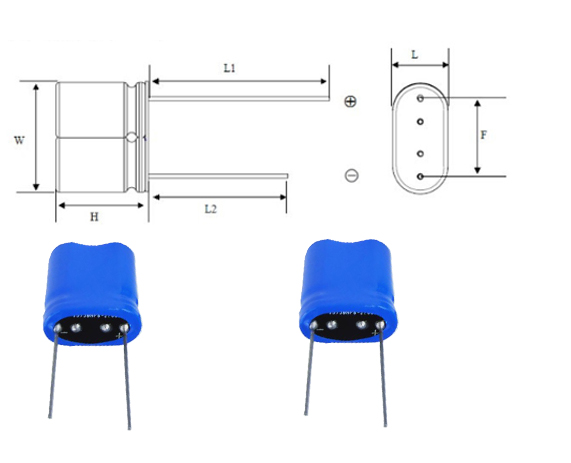Consulting phone:
135-3037-2041
(Mr.Wang)
Product introduction:
Farad lithium-ion capacitor has extremely low self-discharge, which can ensure long-term charging even in high temperature environment. In addition, lithium ion capacitors have no risk of thermal runaway. When designing lithium-ion capacitors, no additional thermal design considerations are needed, and space or components are necessary. The use of lithium-ion capacitors is growing steadily. They are increasingly dependent on supplementary power supply in manufacturing and medical equipment, and even transient voltage drop may be critical. They are used to compensate for the uneven voltage level of solar panels, and even to compensate for the main power supply in small equipment. Most importantly, lithium-ion capacitors are becoming backup solutions for power outages in servers and other devices.
Product specification:
| project | characteristic |
| Rated voltage | 5.5V |
| Capacity | 0.5F~25F |
| Working temperature | - 40 ℃ - 65 ℃ |
| Tolerance | 0+30% |
| Rated voltage | 5.5V |
| surge voltage | 5.7V |
| Temperature characteristics | from - 40 ℃ to 65 ℃ Capacity change: △ c ∠ 30% of initial measured value @ 25 ℃ Internal resistance change: △ ESR ∠ 100% of nominal value |
| Under high temperature load life of | 25 ℃ and rated voltage, load 1000h capacity change: △ c ∠ 30% of initial measured value @ 25 ℃ internal resistance change: △ ESR ∠ 200% of nominal value |
| Under normal temperature load life of | 25 ℃ and rated voltage, load capacity change in 10 years: △ c ∠ 30% of initial measured value @ 25 ℃ internal resistance change: △ ESR ∠ 200% of nominal value |
| Under normal temperature cycle life of | 25 ℃, after 500000 charge-discharge cycles (from rated voltage to 1/2 rated voltage), capacity change: △ c ∠ 30% of initial measured value @ 25 ℃ internal resistance change: △ ESR ∠ 200% of nominal value |
Product display:
Model | voltage V | capacity F | DC internal resistance m Ω | AC internal resistance m Ω | Leakage current uA72hrs | Weight g | L*W*H(mm) |
YKY | 5.5 | 0.5 | 800 | 420 | 0.008 | 2.6 | 16.7*8.5*15.4 |
5.5 | 1 | 520 | 280 | 0.010 | 3.5 | 16.7*8.5*22.3 | |
| 5.5 | 1.5 | 320 | 180 | 0.012 | 3.6 | 16.7*8.5*22 | |
| 5.5 | 2 | 120 | 40 | 0.013 | 3.75 | 16.7*8.5*22 | |
| 5.5 | 2.5 | 260 | 140 | 0.016 | 3.8 | 16.7*8.5*23 | |
5.5 | 3.5 | 180 | 130 | 0.02 | 4.6 | 16.6*8.5*31.8 | |
5.5 | 4 | 100 | 80 | 0.01 | 8.5 | 25.6*13*23.7 | |
5.5 | 5 | 140 | 100 | 0.03 | 7.8 | 25.6*13*23 | |
5.5 | 5 | 140 | 100 | 0.04 | 10 | 25.6*13*27.4 | |
| 5.5 | 9 | 100 | 70 | 0.05 | 9 | 25.6*12.5*25 | |
| 5.5 | 10 | 100 | 80 | 0.06 | 12 | 33*17*33 | |
| 5.5 | 15 | 80 | 64 | 0.10 | 13.5 | 37*17*33 | |
| 5.5 | 25 | 70 | 50 | 0.14 | 14.6 | 37*18*42 | |
| The above dimensions are not specified, and are customized according to requirements | |||||||
Product display:


Dimensions (unit: mm)

Application field:
1) Portable equipment: notebook computer, video camera, PDA, digital camera, portable DVD, etc 2) Household appliances: two-way radios, walkie talkies, electric toys, electric bicycles, emergency lighting 3) Military equipment 4) Medical treatment 5) Electric tools
![1677199467122442.png @K}RO@}2GS}O7])T_TR)23R.png](http://en.szsyky.cn/data/upload/202302/1677199467122442.png)
The double-layer supercapacitor module has the following advantages:
1. Green energy (activated carbon) does not pollute the environment.
2. Long service life (100000 times of charging); The lead-acid battery has a short life (500 times of charging), is easy to be damaged and difficult to manage. It is 20-200 times as long as the lead-acid battery and can share the same fate with the equipment.
3. Fast charging speed (0.3 seconds - 15 minutes); Lead-acid batteries have a long charging time (5-8 hours). Many batteries have a long charging time and a short driving range.
4. High charge-discharge efficiency (98%); The charge and discharge efficiency of lead-acid battery is low (70%);
5. High power density (10.000W/kg); The power density of lead-acid battery is low (300W/kg), more than 30 times worse.
6. Completely maintenance-free, operating temperature range (- 40~50); The driving range of lead-acid battery electric vehicles at - 40 ℃ is reduced by 90%, and the supercapacitor is only reduced by 10%.
7. In the electric bus, the energy recovery is strong, and the emergency braking energy recovery is up to 75%; The energy recovery of lead-acid batteries is only 5%, which is too important for public buses and can save a lot of fuel.
8. The relative cost is low. The price of supercapacitors is twice as high as that of lead-acid batteries, and the price will drop after mass production; However, the service life of supercapacitors is 10 times longer than that of lead-acid batteries, which is very important for the industrialization of public buses.
9. It has the function of over-temperature and over-pressure automatic alarm, which can better protect other equipment and ensure the normal operation of the equipment;